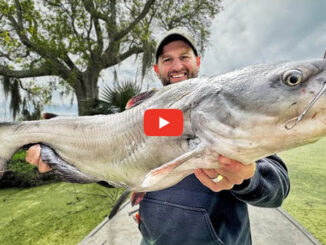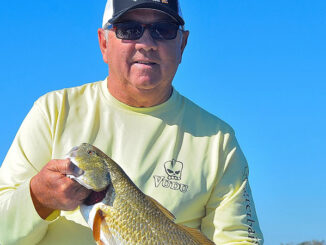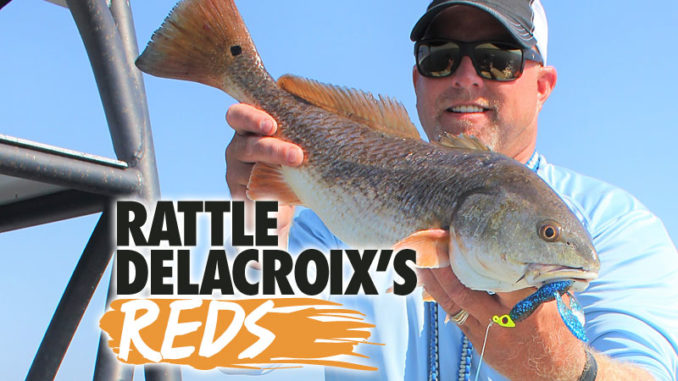
Study the bottom, the water, the bait and find places that are holding redfish for a reason. Then, this guide says, go catch ‘em.
The redfishing in Delacroix is as hot as a fever blister on a june bug. That’s no surprise; it looks like there could be a redfish on every shoreline, but the enormity of the marsh can make consistently finding hungry ones a challenge.
One guy who always seems to know what cove to look in is Casey Brunning of Hurricane Bay Charters, who calls Delacroix his home waters; he’s fished them since he was a kid.
“I’ve been fishing since I could walk,” he said. “My dad was a top-10 Louisiana bass angler in the mid-70s, and (he) drug me along fishing all over the state.”
Brunning developed an affinity for the Delacroix area while fishing tournaments in the early 90s when Caernarvon was the place to be.
“It’s has always been special place,” he said, “and back then, you could go out to Whiskey Bay and crush the trout by 7 a.m., then catch all the redfish you wanted on your way back in.”
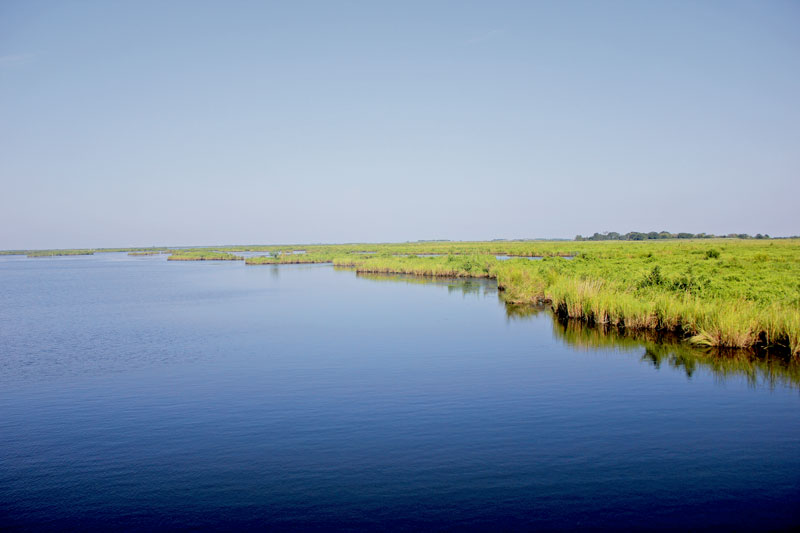
On the clock
Now, after better than six years at the helm of his guide business, Brunning is on the water for more than a hundred trips a year, but the time guiding is only part of the story.
“When I started, I’d spend 12 hours on the water in advance of every trip,” he said. “Even now, I don’t want to be the guy who doesn’t know where the fish are.”
Spending time on the water means Brunning can execute two strategies that ensures he can produce fish. The first is eliminating water that isn’t holding fish. To that end, Brunning scouts from a Majek RFL Tower boat, which offers an unbelievable view. From the elevated cockpit 12 feet above the surface, Brunning is able to drive in and out of shallow coves, through tiny trenasses and backwater ponds and find redfish without wetting a line.
Beyond the boat’s mobility in skinny water, the elevation advantage compared to a traditional boat is the difference between LSU’s offense last year and the previous 125. The entire playing field comes into focus: depth changes, submerged-vegetation patterns, baits and the actual reds.
Brunning is not only trying to hone in on areas holding fish; he’s not just looking for a redfish fish here or there — he’s searching for pockets of fish. Locating a group of fish tells Brunning that the conditions are conducive to holding fish, and that likely means that the fish may sit tight for a period of time.

The bottom counts
At surface level, the marsh’s shoreline looks consistent, but perched on a tower, anglers can see the variations in the bottom. Whether it’s holes where oyster shells pile up or more shallow banks where a point is dissolving, these geographically changes provide refuges for bait and potential ambush points for predators. Brunning targets these changes to find fish.
Changes in the bottom contour also changes the submerged aquatic vegetation. What appears at first glance to be a solid grass mat may have holes and gaps that are visible from a bird’s-eye view. There are too many types of submerged grasses to count, and they are continually growing, dying and re-growing. Stagnate, floating slime is as bad as it looks, but new growth is another story.
“I like the brand-new, bright-green slime on the bottom,” he said. “Redfish like to sit in it.”
This eagle-eyed vision is dependent on a major variable: water quality. It sounds counter-intuitive, but locating the prettiest, gin-clear water is not always the goal. Anglers are just as visible to the fish in crystal-clear water. A calm, clear, leeward shoreline will virtually erupt with activity if a tower looms over the water. Any mullet in a 5-block radius will scatter like roaches with the lights on, alerting redfish that something’s off.
“This is why I prefer clean to stained water,” Brunning said.
Water a few shades darker keeps the environment calm and easier to stalk redfish. It’s particularly important in the stained water, that anglers should start looking for the telltale redfish push instead of an obvious orange glow.
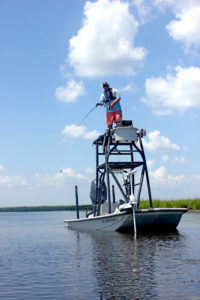
Not all bait is created equal
Contrary to its moniker, sight-fishing doesn’t mean actually seeing the redfish you’re targeting. Most of the time when Brunning is running, he’s looking for the distinctive, heavy push a redfish makes as it swims. Fish behave differently, and their behavior produces a distinct pattern in the water. Mullet appear to be nearly in panic mode as they swim away from the slightest disturbance, dodging and darting in all directions. Reds pulse and produce a straight, heavy wake.
It’s because of a mullet’s panicky nature that Brunning doesn’t consider them a particularly good indicator.
“I generally don’t fish around mullet,” he said. “The schools will bump the redfish off, because they are so spooky and turn everything up.”
Balls of fingerling mullet, small crabs and even freshwater species like bream are good signs of a productive area. Stingrays are also a good sign, and not because reds are eating the rays, but stingrays and redfish share the same tastes in habitat. It’s common to see stingrays resting and feeding while sight-fishing for reds.
Brunning’s go-to artificial bait is the Matrix Craw in cobalt color. He pairs this with a Knotty Hooker jighead, and it doesn’t take much imagination to see a small, blue crab. He ties this it to 50-pound Suffix Braid, and when a red takes the bait, it ain’t going nowhere. One time, on a hookset, Brunning actually jerked a 5-pound red completely out of the water.
In addition to his usual boat, Brunning is a veteran kayak fisherman, having competed in a number of kayak tournaments, winning a world championship in the process.
“Being in a kayak sharpens your skillset,” he said. “You’re limited in the amount of opportunities to fish. Instead of fishing every point in a bay, you are forced to fish every detail on the shoreline, every ripple, every blade of grass. This makes you fish slower. When you’re fishing that slow you become hyper away of bumps on the line. You learn to feel a drag on your line and know it’s a fish.”
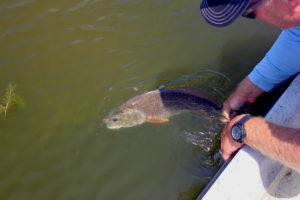
A pro’s outlook
There are a few snags to avoid if you’re thinking about scratching that tournament itch. Anglers should consider avoiding the philosophy of chasing a weight. Limiting the fish you keep to only those above a specific weight can lead to inadvertently missing winning fish. Something as simple as low-tide range may have the fish not feeding actively, producing lower weights across the board. Brunning’s advice is: “We target two 26¾-inch fish; Mother Nature is going to determine how heavy an individual fish is.”
Lockjaw is another hurdle to overcome.
“When I go to three spots, and the fish aren’t eating, it tells me they are community fish,” Brunning said. “They’ve been hit by other anglers (and) bowfishermen or bumped by boat traffic. It’s tough to leave fish, but we get out of an area when they won’t bite.”
Learn hard, work hard
Sight-fishing for redfish is what bowhunting is to deer hunting. You might catch better numbers drowning shrimp, but the thrill of watching a redfish inhale your lure is worth a couple fewer fillets. The other benefit is the increase in your fish IQ. Any bowhunter will tell you, you learn a lot more when deer are at 20 yards than at 200.
Brunning’s success isn’t about his GPS waypoints. It’s the volume of experience with all types of fish, locations, and techniques. Whether you’re in search of a box of reds or a tournament pig, take a page out of Brunning’s playbook and put in the work.
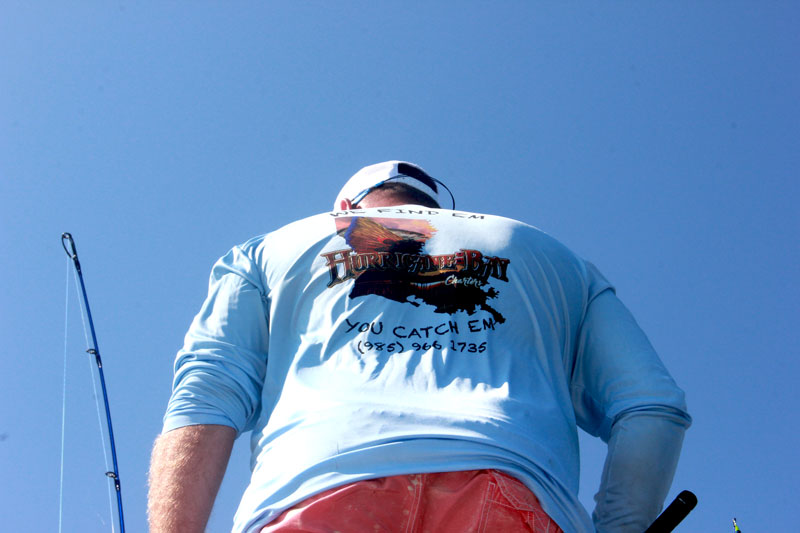
What’s in a name?
All weekend warriors have the same question for a guide:
“Where you’d catch them at?”
Any good guide won’t tell you, “In the mouth.” With the speed that good news travels on Facebook, Instagram and a host of other gossip platforms, a spot holding fish will get plenty of attention.
One summer when Casey Brunnings started guiding, he and a buddy were consistently on fish in a spot known as “Pole Cat Bend” near the Rigolets. The old wives’ tale was, that particular area had been created by the storm surge from a hurricane that created a large washout in the small island.
As Brunning recalled, “All the reports were struggling. Even guides weren’t posting good catches. But we were crushing the fish on every trip.”
Naturally, Brunning started fielding a lot of questions about where he was catching fish. With the skill of a seasoned veteran he didn’t hesitate: “They’re in Hurricane Bay.” When no one could find Hurricane Bay on the interweb, Brunning said, “You gotta look at an old map, like your grandpa’s old paper maps.”
And so, Hurricane Bay Charters was formed.
Capt Casey Brunning can be reached at captaincaseyfishing@gmail.com or 985-966-1735. Find out more about Hurricane Bay Charters at hurricanebaycharters.com.

